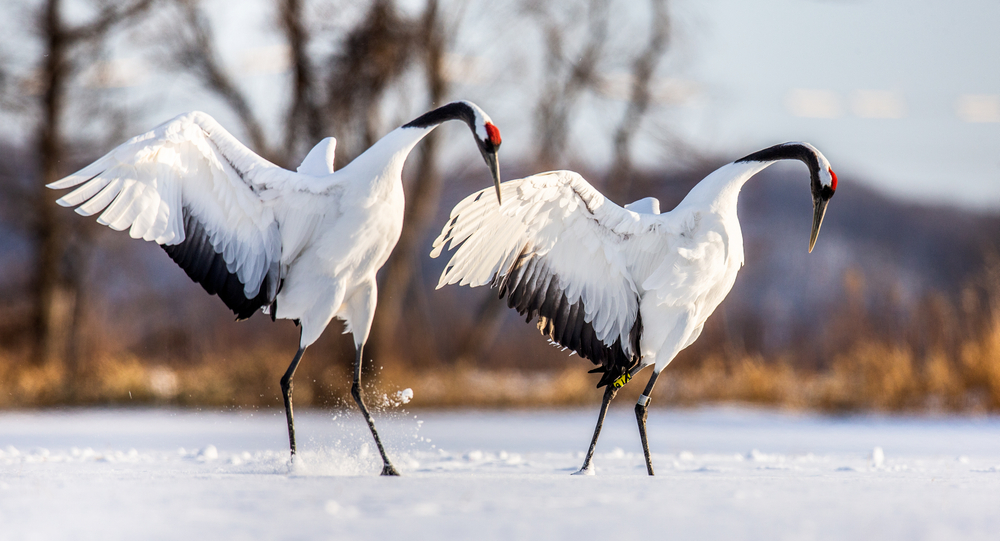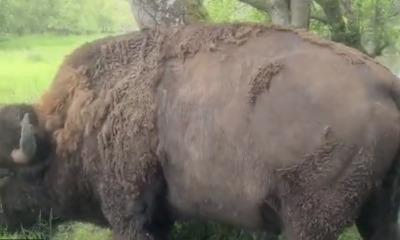ANIMALS
Cranes Are More Interesting Then You May Think, Here Is Why
Published
2 months agoon

Shutterstock
Cranes are birds that do not seem that interesting. If you live in the right area, you can see a crane pretty much everywhere you look. Because of how mundane these birds may seem, their uniqueness is often overlooked. Cranes have a lot of characteristics that are extremely special, and to some cultures, these birds are exalted. Cranes may seem boring, but we promise there is more to them than meets the eye. Here are 29 things that separate cranes from other birds.
Cranes are large birds

Shutterstock
Cranes are among the largest birds in the world, characterized by their long legs, elongated necks, and wide wingspans. These physical traits allow them to stride through wetlands and soar across vast distances with ease. Their size and grace have made them iconic in many cultures and ecosystems. Despite their size, cranes are remarkably agile and adapt well to different environments.
There are 15 species of cranes

Shutterstock
Cranes are divided into 15 distinct species, each with unique traits and habitats. From the elegant red-crowned crane of Asia to the resilient sandhill crane of North America, these species span diverse ecosystems. Some species are critically endangered, like the whooping crane, while others thrive in broader ranges. Conservation efforts focus on preserving each species’ unique habitat and preventing extinction.
Cranes are found on every continent except Antarctica and South America

Shutterstock
Cranes inhabit diverse regions across six continents, avoiding only Antarctica and South America. Their habitats include wetlands, grasslands, and even some desert areas. Adaptability allows them to survive in varying climates, from the Arctic tundra to subtropical zones. However, habitat loss in these regions threatens their populations globally.
Cranes are known for their elaborate courtship dances

Shutterstock
Cranes perform intricate courtship dances, involving leaping, bowing, and wing-flapping. These displays strengthen bonds between mating pairs and communicate fitness. The dances are often accompanied by synchronized vocalizations, adding to their allure. This behavior highlights their complex social interactions and serves as a spectacle in the wild.
Cranes are monogamous and often mate for life

Shutterstock
Most crane species form lifelong pair bonds, showing strong fidelity to their mates. These bonds are reinforced through mutual care of eggs and chicks. Both partners actively participate in nest building, incubation, and rearing of their young. This enduring partnership ensures higher survival rates for their offspring.
Cranes can live up to 30 years in the wild

Shutterstock
With proper environmental conditions, cranes can reach impressive lifespans of up to three decades. Their longevity is influenced by factors like predation, habitat quality, and human interference. In captivity, cranes may live even longer due to reduced threats. This extended lifespan allows them multiple breeding opportunities throughout their lives.
Cranes are omnivorous

Shutterstock
Cranes have a versatile diet that includes both plant and animal matter. They feed on seeds, roots, grains, insects, small mammals, and aquatic creatures. This dietary flexibility helps them survive in various habitats and seasons. Their ability to forage effectively plays a crucial role in their adaptability to environmental changes.
Cranes have long legs

Shutterstock
Cranes’ long legs are perfectly adapted for wading through wetlands and shallow waters. These legs allow them to search for food while keeping their bodies above water. Additionally, their powerful legs are built for efficient locomotion, whether walking across grasslands or performing their iconic courtship dances. Their leg structure also helps them evade predators with swift movements.
Cranes have long necks

Shutterstock
The elongated necks of cranes are a key adaptation for feeding and communication. They use their necks to reach deep into water or soil for food, giving them access to resources unavailable to other species. Their long necks also enhance their visual range, helping them detect predators and interact with their surroundings. These elegant features contribute to their iconic appearance and functionality.
Cranes are excellent fliers

Shutterstock
Cranes are powerful and efficient fliers, capable of covering vast distances during migration. They use thermal air currents to soar, conserving energy as they travel between breeding and wintering grounds. Their broad wings provide the lift needed for long-distance flights and maneuverability. These flight skills are essential for their survival, especially in migratory species.
Cranes migrate seasonally

Shutterstock
Seasonal migration is a vital behavior for many crane species, enabling them to access food and breeding grounds. They travel in large flocks, often forming striking V-shaped formations in the sky. These migrations are synchronized with changing seasons, ensuring they avoid harsh climates and scarce resources. Migration routes can span thousands of miles, showcasing their endurance and navigational skills.
Cranes often nest in wetlands

Shutterstock
Wetlands provide ideal nesting sites for cranes, offering abundant food and protection from predators. They build large nests on the ground, often in marshy areas surrounded by water. This strategic location helps deter land-based threats and supports their chicks’ survival. Wetland conservation is critical to ensuring cranes have safe nesting habitats.
Cranes use vocalizations to communicate

Shutterstock
Cranes rely on a range of vocalizations to communicate with each other, from soft calls to loud trumpeting sounds. These calls serve various purposes, including warning of danger, maintaining contact during migration, and strengthening pair bonds. Vocalizations are often species-specific, enabling cranes to identify their own kind. Their voices can carry over long distances, making them effective in open landscapes.
Cranes have a loud, trumpet-like call

Shutterstock
One of the most distinctive features of cranes is their loud, resonant call, resembling a trumpet. This unique sound is produced by their long windpipes, which act as a natural resonator. The calls are used for mating, communication during flight, and territorial defense. These vocalizations make cranes easy to identify even from a distance.
Cranes are symbols of longevity in many cultures

Shutterstock
In many cultures, cranes are revered as symbols of longevity, wisdom, and good fortune. They feature prominently in Asian art and mythology, often associated with eternal life. In Japan, cranes are considered sacred and are folded into origami as a wish for peace and prosperity. Their majestic presence continues to inspire awe and respect worldwide.
Cranes often travel in flocks

Shutterstock
Cranes are highly social birds that often travel and forage in flocks. These groups provide safety in numbers, reducing the risk of predation. Flock dynamics also help in locating food and navigating migratory routes. The sight and sound of cranes flying together are among nature’s most remarkable spectacles.
The whooping crane is one of the rarest crane species

Shutterstock
The whooping crane, native to North America, is one of the most endangered crane species. With a striking white plumage and black wingtips, it stands out in its wetland habitat. Conservation programs have helped its population rebound from just 21 individuals in the 1940s. However, habitat loss and climate change remain significant threats to its survival.
Cranes are territorial during the breeding season

Shutterstock
During the breeding season, cranes become highly territorial, defending their nesting sites from intruders. They use vocal displays and physical posturing to ward off rivals. This behavior ensures their eggs and chicks remain safe from competition and predation. Territoriality is a critical aspect of their reproductive success.
Cranes can adapt to various habitats

Shutterstock
Cranes are highly adaptable birds that thrive in diverse environments, from wetlands to grasslands and agricultural fields. This adaptability allows them to survive in areas affected by human activity. They can shift their diets and nesting behaviors to suit available resources. However, their reliance on specific habitats for breeding makes them vulnerable to environmental changes.
Cranes build large, ground-based nests

Shutterstock
Cranes construct their nests on the ground, often in secluded areas surrounded by water. These nests are made from plant material such as reeds, grasses, and sticks. The size and location of the nest help protect the eggs from predators and environmental threats. Both parents actively participate in building and maintaining the nest throughout the breeding season.
Cranes have strong family bonds

Shutterstock
Cranes exhibit strong family bonds, especially during the rearing of their young. Both parents take turns incubating the eggs and feeding the chicks once they hatch. Young cranes, known as colts, stay with their parents for months, learning essential survival skills. These bonds ensure the next generation is well-prepared for independence.
Sandhill cranes are the most common crane species in North America

Shutterstock
Sandhill cranes are the most widespread crane species in North America, known for their distinctive red crowns and gray feathers. They are highly adaptable, thriving in wetlands, grasslands, and agricultural fields. Each year, thousands of sandhill cranes gather during migration, creating a spectacular natural event. Their population success contrasts with the struggles of other crane species.
Cranes are protected under international conservation laws

Shutterstock
International conservation laws aim to protect cranes and their habitats from threats like poaching and habitat destruction. Agreements like the Convention on Migratory Species help coordinate global efforts to ensure crane populations remain stable. Protected areas and wildlife reserves play a crucial role in their survival. Despite these measures, ongoing conservation efforts are essential to safeguard their future.
Cranes have been featured in folklore and art worldwide

Shutterstock
Cranes hold a special place in folklore and art across various cultures, symbolizing peace, longevity, and grace. They appear in ancient Chinese paintings, Japanese origami traditions, and African storytelling. Their elegant movements and striking appearance make them a popular subject for artists and writers. This cultural significance underscores their importance beyond ecological roles.
Cranes play a role in maintaining wetland ecosystems

Shutterstock
Cranes contribute to the health of wetland ecosystems by dispersing seeds and controlling insect populations. Their foraging activities aerate the soil, promoting plant growth. Wetlands, in turn, provide essential resources like food and nesting sites for cranes. Protecting cranes indirectly benefits the biodiversity and balance of these critical habitats.
Cranes have a preening gland for waterproofing feathers

Shutterstock
Cranes have a specialized preening gland, known as the uropygial gland, located near the base of their tails. This gland secretes oils that cranes use to waterproof their feathers. They spread this oil during preening, maintaining the condition and functionality of their plumage. This adaptation is crucial for surviving in wet environments and maintaining their ability to fly effectively.
Cranes molt their feathers periodically

Shutterstock
Like many birds, cranes undergo molting, a process where old feathers are replaced with new ones. This typically occurs annually and is essential for maintaining the bird’s health and flight efficiency. During molting, cranes may temporarily lose their ability to fly, making them more vulnerable to predators. Proper timing and safe habitats are critical to ensuring their survival during this period.
Cranes are sensitive to habitat changes

Shutterstock
Cranes are highly sensitive to changes in their habitats, including pollution, drainage of wetlands, and urban development. These disruptions can reduce the availability of food and nesting sites, directly impacting their populations. Conservationists work to restore and protect critical habitats to counteract these threats. Awareness of their ecological needs is key to ensuring their survival amid human activities.
Cranes are considered sacred in some cultures

Shutterstock
Cranes hold sacred status in several cultures, symbolizing harmony, longevity, and spiritual balance. In Hindu mythology, cranes are associated with patience and meditation. Native American tribes often regard them as messengers of peace and wisdom. These deep cultural connections highlight the enduring admiration and reverence for cranes across the world.
Conclusion

Shutterstock
We hope that we have changed your mind about cranes. These birds may not be super interesting to look at, but under the surface are many unique traits that make them extremely special. Even if we still haven’t convinced you that cranes are pretty cool, all animals deserve love and some attention, and that is a win in our book!
More Amazing Animals+
-


Vitakraft’s Squeezable, Hand-Fed Snacks Named Best Cat Treat of 2022
-


27 Animals That Look Like They Could Be A Cartoon…
-


Alligator Crosses the Walkway with Bird Looking On in Hunstville,…
-


Beyond the Stripes: 25 Intriguing Zebra Facts That’ll Amaze You
-


30 Most Unusual Rainforest Animals
-


25 Animals That Survive Better In The Colder Weather
-


An Alligator Causing Havoc In Florida Woman’s Yard is Finally…
-


Bison bull caught scratching away the last bit of his…
-


25 Fascinating Facts About Elephants
-


47 Animals That Don’t Need Eyes To See
-


27 Animals That Live In The Most Extreme Conditions
-


These are the snacks experts say cats are really into…
